PACKAGING
BEHIND THE DESIGN - Label by peter stougaard
Says Mary-Colleen Tinney of Wine Business Monthly, ” EVERY WINERY KNOWS THAT strong packaging helps their brand. It conveys to the consumer, who may or may not have ever tried the wine inside, a glimpse into the traditions, character and story of the brand. For traditionally packaged wines, the label and capsule choice are usually the components that convey these messages. Most domestic wines, after all, are bottled in widely available stock bottles, where the extent of the winery’s choices are, essentially, deciding between Bordeaux or Burgundy, dead leaf or antique green. This is true of wineries of all case sizes, and at the high-end or low.This is not to disparage the American winemaker. Though the smooth, plain-finished effect stock bottle is visually similar across many brands, most wineries are choosing their glass carefully to fit their needs. They are opting for a bottle that complements their wine and their label design while also fulfilling their needs for more practical concerns, like desired bottle weight, ease of use on the bottling line and efficiency in shipping and storage.”
Kinsella Estates: On a Stretch of the Hand
Kevin Kinsella, proprietor at Kinsella Estates, a 2,500-case winery based in Dry Creek Valley, always planned on his bottle being different. A venture capitalist by trade, Kinsella was the largest investor in the theatrical hit “Jersey Boys,” an investment that guided many of the choices for his wine packaging. Kinsella Estates offers two wines, both Cabernet Sauvignon sourced from estate vineyards, retailing for $125.
“It’s a custom bottle shape, but the exact dimensions are proprietary,” said Kinsella. The look is sleek and tall, with a long neck and a front “label” that is actually a commemorative metal coin hand-glued into a raised ridge cartouche element on the bottle’s shoulder. “It’s a design that I particularly like because it has a nice flow weight to it. When someone picks up a bottle of wine and it’s heavy and dark and majestic-looking, it enhances the perception of value. And if you don’t like the wine, at least you’ve got a lot of glass.“I wanted to think outside the box,” added Kinsella. “I didn’t want to hire one of the traditional or top wine label designers that you can find through the usual sources. So I made a phone call to Peter Stougaard, who at the time was in charge of all pre-release publicity for 20th Century Fox in Los Angeles. He was originally a graphic artist, so I figured he may know someone who might have some really creative ideas. He said that he would rather do it himself. It was fun. He involved a lot of other people in the movie business.”
The idea for the cartouche and coin insert came from Stougaard and his team. Their plan was for the coin to become a collectible for consumers, a novel way to remember the wine. Kinsella reported that people have used the coin as a golf ball marker and even as a pendant. He himself frequently uses the coin in lieu of a business card. “I thought it was great because it is removable,” he said. “On the back of the coin there’s all this iconography you can’t see when it’s on the bottle.The coin says Kinsella Estate, and above that, it says in Italian, Su Una Stretto Di Mano, which literally means ‘on a stretch of the hand,’ the Italian term for a handshake. That’s how I have always liked to do business, and it was reminiscent of the show ‘Jersey Boys.’ When you look on the back of the coin, there are four icons that represent the four seasons of the vine. But it also is a reference to the show because it’s the life story of Frankie Valli and the Four Seasons. I thought that was a neat creative touch.”Though the cost to do the bottle and coin—which is more than $2.25 per piece—is high, Kinsella believes it fits his limited production, higher-end wine. “You have to have a certain bottle price to make it. It’s not like buying a stock bottle. But on the other hand, it’s not that expensive. Really, if you can get a good price for the wine, it just becomes part of the cost of goods sold. It’s manageable within the constraints of doing that.” – WBM October, 2014



